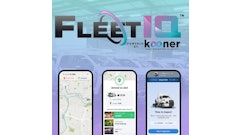
The “Norm”…Remember that? It’s something we’re all longing for, but until the Coronavirus disease (COVID-19) goes away, life continues to be an adjustment. For those in trucking, who are used to in-person orientation and classroom training programs, delivering the same content has meant new challenges and keeping drivers’ attention.
The new normal, for now anyway, means presentations via Zoom, WebEx, Skype and Microsoft Teams. They’re the de facto standard tools instead of whiteboards, flip charts and overhead projectors.
On the surface, the delivery should be the same -- it’s still a live session featuring slides and an instructor leading people through the content. The reality, of course, is quite different. As those in-person programs have moved online, facilitators have discovered that there are actually major differences between the two delivery methods. To deliver virtual training and presentations successfully, those differences need to be recognized and the special challenges of a virtual environment need to be addressed.
Here are five things to consider to maximize the effectiveness of live online delivery.
Social cues
Within a group setting – a physical classroom for example – students are not only focused in on the presenter, but they’re also aware of their surroundings. They’re seeing and reacting to social cues that other participants are picking up on during the event. If everyone else is paying rapt attention to the speaker, students will feel like they should as well. If others are zoning out, they’re more likely to do it too. It’s up to the instructor to keep the students engaged both verbally and visually.
In the context of a conference presentation or meeting, that can extend as far as determining whether or not people stay or leave the session. In a physical presentation at a conference, attendees – without the luxury of mandatory attendance -- may realize they're not interested in the content. Or, worse yet, the information might be relevant, but the presenter lacks engagement – four cups of coffee wouldn’t even help and the body language of others in the presentation confirm what you’re thinking. Time to leave. But, they'll weigh that thought against the amount of disruption they’ll cause by walking out. That’s why a lot of people, who may have been on the fence on attending the presentation in the first place, sit on the end of a row or take seats in the back. It makes a hasty, quiet exit, so much easier.
Online, however, none of the social factors exist. Even in virtual training sessions where the cameras are on, you still can’t tell exactly what the other participants are doing or how they’re engaging. That means participants can tune out more easily, do something else without it being obvious, or leave the session altogether. To prevent that, those virtual sessions need to be a lot more compelling. The instructor has to be more dynamic as do new ways of illustrating the presentation.
Competition for attention
While social cues go out the door in a virtual session, in come new distractions. Well, they’re not new, but they are looked down upon in a physical setting. The cell phone. In a classroom, it’s a good bet that the instructor can see each time a participant looks down at his or her phone or stops paying attention to the speaker. Online? Not so much.
Even with cameras on, it’s impossible to know if the participant is looking at the presentation or something else. If they’re typing, are they taking notes (which many people do as a way of learning the content) or are they sending messages to their friends? When they’re not taking notes are they paying attention to the speaker or surfing other sites?
Much like the social cues in a physical class that keep people paying attention, the physical immersion in a dedicated environment helps to keep people focused on the subject at hand and not distracted by other things. When they’re away from that physical environment, sitting at their desk with all the various notifications popping up and the lure of easy access to activities that escape the eye of the instructor, it's a lot harder for people to stay zeroed-in on the speaker.
Putting these two points together - lack of immersion in the physical environment and lack of social cues driving behavior - it's easy to see the added challenge virtual delivery faces. Without those elements to help out, the presentation itself - the speaker, the content, and the slides - needs to be put in overdrive to maintain the engagement level.
Speaker quality
Many instructors do the job because they know the content well and are comfortable talking to an audience. That’s not the same as being a compelling speaker, engaging educator, or great curriculum designer. In a physical environment where everyone is together, you can get away with that – content trumps presentation. Think of the many examples of “instructors” who stand at the front and either read the slides or just recite stories from their own experience.
Online, that doesn’t work. Without the supports provided by a physical attendance, a lackluster delivery falls flat and loses the audience. Fast. Once you’ve done that, there’s really no returning - the participants won’t respect or pay attention to what you're saying.
To make online delivery work, instructors need to be able to speak comfortably at a consistent pace, with inflection and energy in their voice, and without endless umms and uhhs. It doesn't need to sound like an over-caffeinated radio DJ, but it does have to have pacing and life in the voice. Think of a newscaster and how that person delivers content in a way that the audience follows, while keeping them interested and engaged. It requires speaking with a certain amount of polish -- rising and falling pitch in the voice with no monotone sections, strong consonants, so it’s clear what’s being said, and most of all, no reading of the slides.
The key to making it all work with a delivery that keeps the audience engaged is to rehearse. And, then when you’re done, rehearse again. If the slides are built today and the session delivered tomorrow, without any rehearsing in between, it will sound rough and clunky. Rehearsing and being comfortable with the material will help avoid stumbling or sounding like you’re rushing through it. The effort will pay off. Even two run-throughs, going end-to-end without stopping, will make a big difference in the smoothness of the delivery during the live session.
Slide content
Building on the last point, slides and visuals need to give people something to look at that isn’t in the script you’re presenting. It doesn’t have to be a lot -- it can be an image that illustrates your point, maybe the key points in bullet form -- but it needs to be something for the audience to use as a mental bookmark for the content you’re presenting.
And, you don’t always have to rely on slides. Sometimes videos can work, and sometimes just cut the slides altogether and have your face on screen. That can be great way to connect better with the audience, but it has its own set of challenges, which leads us to…
Lights, camera, sound
This is an area that has become endlessly fascinating, especially since the entire world has moved to virtual meetings, classes and interviews. Watching interview segments on the news and infotainment shows, you see a wide variety of camera positions, lighting setups, and audio quality. It all makes for a much bigger difference in the final product than the speakers appear to realize.
To do it right, there are some simple steps that anyone can follow:
- If at all possible, have the camera at or slightly above eye level. No one wants to look up your nose, but the camera shouldn’t be too high above your head either (it’s not a selfie).
- If you’re sitting down, position yourself close enough to the camera that you’re visible from the chest up. If you’re too close it can look like a disembodied head on screen, and if you’re too far it will pick up too much hand movement that can be distracting for the audience.
- Adjust the lighting to minimize shadows. There are standardized lighting setups that professionals use and you can mimic that pretty well with just a couple of lamps and selective use of curtains or blinds to control natural light.
- Use wireless headphones/mic or the kind of in-ear phones/mic that typically come with mobile phones. If you use a large over-the-ear headset you look like you’re directing air traffic. If you rely on the computer’s built-in audio you’ll invariably get tons of background noise and poor quality audio. Mobile phone headsets are surprisingly good at providing clean audio, so there’s no reason not to use them.
Put those things together and you’ll be surprised at how much better the picture and audio quality of the presentation is. Add in the points above to create more engaging slides and along with your delivery in a cleaner, smoother fashion, and you’ll be amazed at how much better the finished product looks.
Delivering live training and presentations online may be a new adventure for many people, but it’s not rocket science so anyone can do it well. All it takes is a little preparation and practice. Then it will feel pretty “normal.”

















